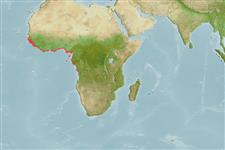Actinopterygii (ray-finned fishes) >
Clupeiformes (Herrings) >
Clupeidae (Herrings, shads, sardines, menhadens) > Dorosomatinae
Etymology: Sardinella: Latin and Greek, sarda = sardine; name related to the island of Sardinia; diminutive (Ref. 45335); rouxi: Named in honor of Charles Roux, director of the 'Centre Océanographique de Pointe-Noire' (Ref. 86940).
Environment / Climate / Range
Ecology
Marine; brackish; pelagic-neritic; depth range 0 - 50 m (Ref. 188). Tropical, preferred ?; 18°N - 10°S, 20°W - 14°E (Ref. 188)
Atlantic Ocean: Eastern Atlantic Ocean from Senegal southward to Congo, possibly to northern Angola (Ref. 188, 5286, 81269, 81631).
Size / Weight / Age
Maturity: Lm ? range ? - ? cm
Max length : 16.0 cm SL male/unsexed; (Ref. 188); common length : 13.0 cm SL male/unsexed; (Ref. 188)
Dorsal
spines
(total): 0;
Dorsal
soft rays
(total): 16-19;
Anal
spines: 0;
Anal
soft rays: 16 - 21. Diagnosis: Body moderately deep, belly fairly sharply keeled (Ref. 188). Lower gillrakers 30-40 (Ref. 188). A black or golden spot behind gill opening; upper part of pectoral fin dusky; caudal fin pale yellow with dusky hind margin (Ref. 188). Sardinella rouxi resembles S. maderensis, which has more gillrakers and a grey caudal fin, its tips almost black (Ref. 188). It is distinguished from small S. aurita by having 1 unbranched and 7 branched pelvic fin rays vs. 1 unbranched and 8 branched in S. aurita, and no black spot on hind part of gill cover (Ref. 188).
Sardinella rouxi is found in inshore waters and along beaches, forming schools (Ref. 188).
Life cycle and mating behavior
Maturity | Reproduction | Spawning | Eggs | Fecundity | Larvae
Whitehead, P.J.P., 1985. FAO Species Catalogue. Vol. 7. Clupeoid fishes of the world (suborder Clupeioidei). An annotated and illustrated catalogue of the herrings, sardines, pilchards, sprats, shads, anchovies and wolf-herrings. FAO Fish. Synop. 125(7/1):1-303. Rome: FAO. (Ref. 188)
IUCN Red List Status (Ref. 115185)
CITES (Ref. 94142)
Not Evaluated
Threat to humans
Harmless
Human uses
Fisheries: minor commercial
More information
Common namesSynonymsMetabolismPredatorsEcotoxicologyReproductionMaturitySpawningFecundityEggsEgg development
ReferencesAquacultureAquaculture profileStrainsGeneticsAllele frequenciesHeritabilityDiseasesProcessingMass conversion
Tools
Special reports
Download XML
Internet sources
